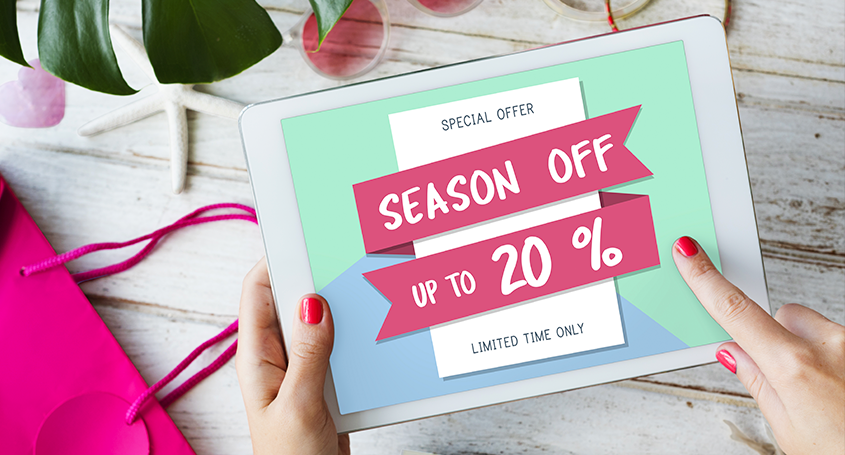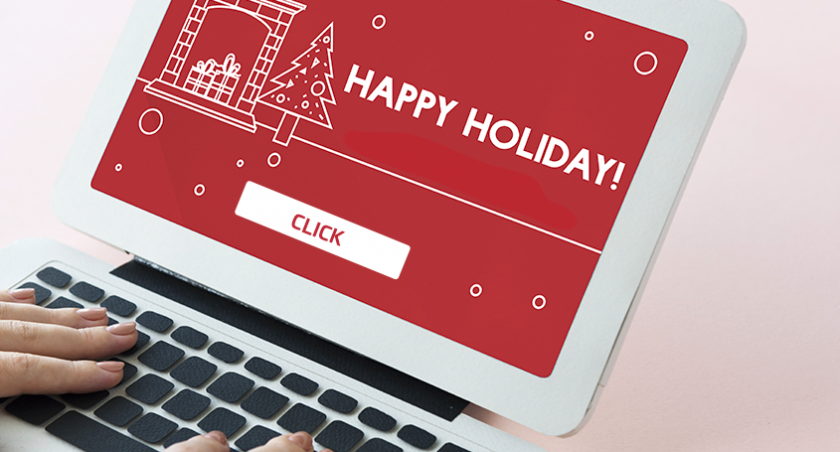Right before the holidays, businesses in the know pump up their email marketing to catch their customers’ attention. To create effective holiday email marketing campaigns, though, companies need to focus on meeting their customers’ needs as opposed to just selling stuff.
Here’s your ultimate guide to a holiday email marketing campaign that will not only bring in customers this year but also build customer loyalty for years to come.
Resist the Temptation to Go Salesy
It’s tempting to focus on your merchandise and services when you look at the holiday numbers. After all, as Forbes’ Scott Darrohn points out, 50 percent of a consumer’s “holiday shopping spree” consists of online sales.
But there’s another statistic worth noting. When you have only a five percent increase in customer retention, you’ll realize a 25 percent increase in profit, as Fred Reichheld points out in a Bain & Company report.
So instead of blatant self-promotion, position your products and services as solutions to your customers’ problems. That’s content marketing: thoughtful, helpful, and well-researched content that targets your customers’ needs this holiday season and throughout the year. After that, this is a great aspect to consider when conducting effective holiday email marketing campaigns.
Done right, it costs 62 percent less than traditional marketing yet yields three times more leads, as Wordstream’s Dan Shewan points out. And, when it meets your customers’ most pressing needs, it also can build loyalty. After all, aren’t you more loyal to people and businesses who help you out?
To do content marketing successfully, though, you need to discover your customers’ needs. That process takes research—so you need to start as soon as possible before the season starts.
First of All, Get to Know Your Customers
Unless your company is the only one of its kind for miles around, it takes more than gossip around the village coffee shop to learn about your target customer base. Take a deep dive into your website and social analytics to see which customers have bought your products or have shown a great interest in your products.

Look at their demographics, their social media likes, their product preferences, and their pain points—those critical issues that keep them up all night. Next, create customer personas to put a human face on each of your ideal customers.
To create a customer persona, you separate all your customers and prospects into groups based on that data—and their pain points. Most companies give them a nickname to remind them about their characteristics and the problems that drive them.
For example, if your business is a high-end online toy store, these might be your ideal customers:
1. “Harried Grandma Harriet,” a busy CEO, has plenty of money but not enough time. She also has a handful of grandkids that consume her brief time away from the job—you know that from social media data gleaned from your customers and prospects. She also loves decorating, but she hires an interior designer to do the nuts and bolts of her design ideas.
2. “Nurse Nancy,” is a young married mother of a toddler and a school-age child, one with ADHD, the other with dyslexia. She hasn’t a lot of money, but she is choosy about what toys she buys her children. A nurse who’s taking night classes to become a nurse practitioner, she knows the value of education—and wants her kids to have toys that will teach as well as entertain. She especially wants toys that will leverage her kids’ preference for hands-on learning to teach them other skills.
3. “Salesman Dad Dan” is a divorced dad with plenty of money and time. Though he loves his kids, he divides most of his time between looking for a replacement for his ex and driving to appointments. He feels guilty about not seeing his kids, so he indulges them with tons of expensive toys on birthdays and holidays.
Customer Personas Help You Tailor Your Email Marketing
The great thing about customer personas is that you can use them to segment your emails. For example, your customer persona “Harried Grandma Harriet” might be a busy CEO, but she has a handful of grandkids that consume her brief time away from the job.
Solving Customer Personas’ Problems with Helpful Content
If you’re an online toy store, “Harriet” and her fictional sisters will probably love a gift-wrapping service, expedited shipping to her door—and she’ll probably be OK with paying extra for those services—even though she’d love to wrap the gifts herself. After all, she doesn’t want to be grumpy from wrapping gifts all night the day before the big holiday.
For all your “Harriets,” a newsletter article that teaches customers effective, yet time-saving holiday tips would definitely be welcome in their inboxes. An article that shares tips on gift-shopping for kids (along with some carefully curated selections with buy-now links to purchase them), as well as tips for wrapping those gifts quickly yet attractively, will be one they’ll archive in their inboxes.
Even though they might not have time to wrap the gifts this year, they want to have those tips on hand for next year. Bonus points if you point out that your company offers free gift wrapping for orders over $200, along with expediting shipping for orders over $300. Not only will you have solved her current problems, but you’ve given her some tips that will make next year’s holiday season easier to plan.
Solving Customers’ Problems, One Persona at a Time
Similarly, you, too, can create content that meets your customers’ needs. For instance, for your “Nurse Nancy” types, you can do some research into what makes the best educational toys for each age group. Cite some noted psychologists and education professionals for added authority. Busy Nancy might, too, like a little help with shopping, wrapping, and shipping.

As for “Salesman Dad Dan,” a newsletter article on dealing with guilt over the holidays might bring some welcome relief—and advice. When you mention some ways that dads can use play to bond with their children, as well as what toys encourage parent-child play, he’ll be likely to become a faithful subscriber to your newsletter.
Native Ads Help Connect Customers to Complimentary Holiday Offers
You don’t have to be a toy manufacturer to see how your business can plug in to similar customer personas’ needs. Let’s suppose you offer online family therapy and these personas characterize your ideal customers as well.
You can bet that newsletter articles that explain how play can help special-needs kids learn (for Nurse Nancy), as well as articles on dealing with non-custodial parent guilt (for Salesman Dad Dan), and balancing corporate stress with a more relaxed personal life (for Harried Harriet) will be welcome, as will your 25 percent offer for therapy sessions during the holiday season.
But along with those articles, imagine what would happen if you placed native advertising from a company whose products also met your customers’ needs at a strategic place in your newsletter copy. Not only would these customers love you for your free advice—and probably reward you with an appointment—but they would also thank you for being so considerate as to help them with their holiday shopping.
Native ads appear like sponsored stories do in your social news feed and other articles. In other words, they look like links to other articles. In fact, if the fictional toy manufacturer uses content marketing to her advantage—they might be.
Learn more about native ads here.
Whether or not they link to informative articles, though, they do link to products and services that your target customers will likely need or want—if you use a robust email monetization platform like inboxAds. Powered by AI, the software uses your target customers’ data to select ads that will make you seem like Santa Claus to your customers come holiday time.
Since they’re advertising products your busy customers likely need for the holidays, they’ll build even more goodwill for you and your business. But first, your customers must open your emails to benefit from both your content and your ads.
Add Holiday Sparkle to Your Subject Lines to Increase Your Open Rate

All that great content will go unread unless your target customers open your emails. As a recent Campaign Monitor article shows, a little holiday bling can make your email subject lines shine this holiday season.
#1. Use fear of missing out (FOMO) to score the open: No one wants to miss out on a discount, some last-minute holiday advice, or other timely information. When you use wording like “Don’t Miss Out on The One Way to Stay Sane This Holiday Season,” you can bet that your Harried Harriets, Divorced Dad Salesman Dans, and Nurse Nancys will open yours first. Words like “Now” or “Don’t Miss Out” trigger the FOMO impulse, says Moveable Ink marketing expert Kristen Dunleavy. She points out that such words can increase your open rate by as much as 22 percent.
#2. Use holiday wording and imagery to underscore your emails’ seasonal appeal: Whether it’s the “12 Deals of Christmas,” “What You Need to Include in Your New Year’s Resolution,” or “Treat Yourself to a Stocking Full of Cheer This Holiday,” your customers will more likely open them. Combine these seasonal headlines with holiday emojis and an appealing holiday image that greets them when they open your newsletter, and you’ll practically guarantee a greater open rate.
#3. Personalize subject lines: People love to see their names in print. When you personalize your subject lines—especially during the busy holiday season—people will be more likely to open your emails—26 percent more likely, says the Campaign Monitor staff.
Keep Track of the Season’s Big Days
Another important aspect is that you need to ensure that you send out newsletters and other key emails well before the major holiday events this season. Here’s a list of some of the most popular ones for 2019 – 2020:
- Black Friday: November 29
- Hanukkah: December 22-30
- Western Christian Christmas: December 25
- Kwanzaa: December 26-January 1, 2020
- New Year’s Eve: December 31
- New Year’s Day: January 1, 2020
- Eastern Orthodox Christmas: January 7, 2020

Optimize Your Emails for Mobile—And Don’t Forget The CTA
Mobile devices are increasingly the go-to device for browsing through your emails. Whether you’re on the bus, grabbing lunch, waiting in line, or taking the subway home, you’ll likely check your emails as you wait. However, make sure your emails give your readers a dazzling experience whether on the road or at home watching TV.
Finally, an important component to consider when conducting effective holiday email marketing is to provide your readers with an engaging call to action (CTA). Whether you want to link it to a purchase page, an e-book offer, or another blog post, make sure that you ask them to engage with your brand.
If you’d like to learn how to monetize email newsletters this holiday season to earn revenue while you cultivate a long-term relationship with your customers, the inboxAds team will gladly help you.






